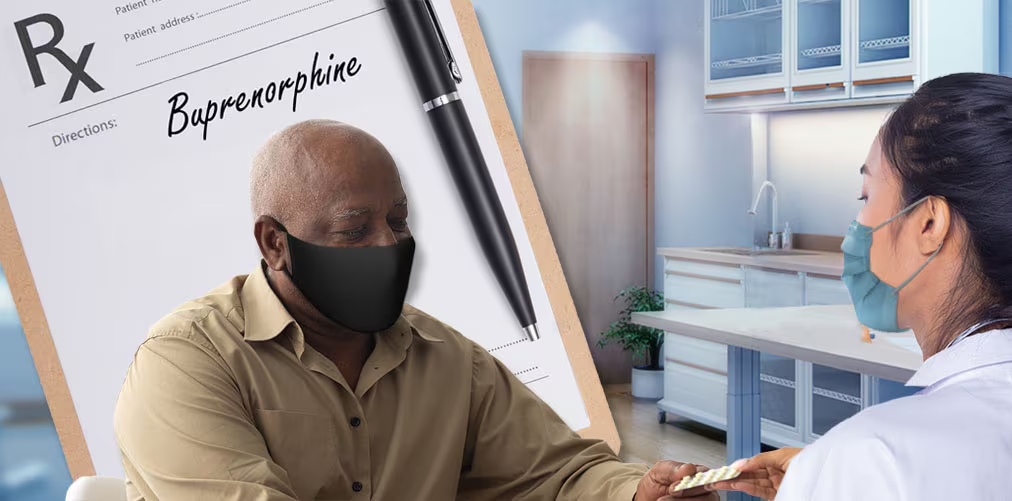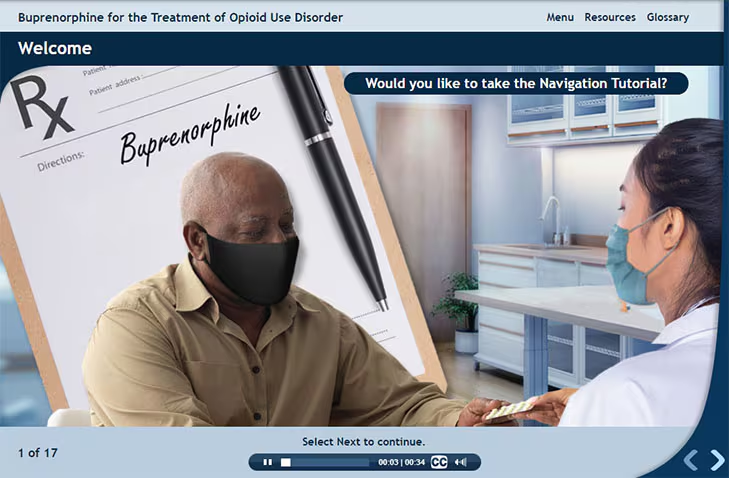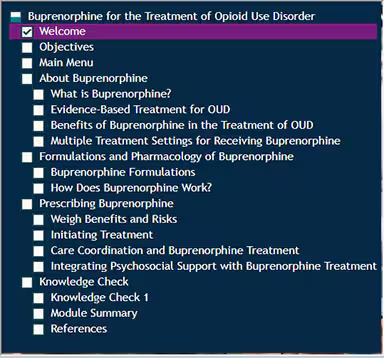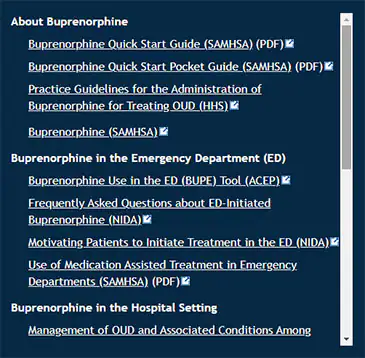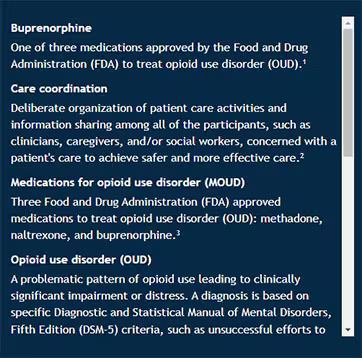About Buprenorphine
Buprenorphine Quick Start Guide (SAMHSA) (PDF)
Buprenorphine Quick Start Pocket Guide (SAMHSA) (PDF)
Practice Guidelines for the Administration of Buprenorphine for Treating OUD (HHS)
Buprenorphine in the Emergency Department (ED)
Buprenorphine Use in the ED (BUPE) Tool (ACEP)
Frequently Asked Questions about ED-Initiated Buprenorphine (NIDA)
Motivating Patients to Initiate Treatment in the ED (NIDA)
Use of Medication Assisted Treatment in Emergency Departments (SAMHSA) (PDF)
Buprenorphine in the Hospital Setting
Buprenorphine in Primary Care
Practical Tools for Prescribing and Promoting Buprenorphine in Primary Care Settings (SAMHSA) (PDF)
Addiction Medicine Toolkit (CDC)
2022 Clinical Practice Guideline
CDC Clinical Practice Guideline for Prescribing Opioids for Pain— United States, 2022 (MMWR)
CDC's Clinical Practice Guideline for Prescribing Opioids for Pain training module
Medications for Opioid Use Disorder
ASAM National Practice Guideline for the Treatment of OUD (ASAM)
Facts for Medication Treatment for OUD (NIDA)
Linking People with OUD to Medication Treatment (CDC)
Medications for OUD, SAMHSA Treatment Improvement Protocol (TIP 63) (SAMHSA)
Follow Directions: How to Use Methadone Safely (SAMHSA) (PDF)
Methadone Take-Home Flexibilities Extension Guidance (SAMHSA)
Clinical Use of Extended-Release Injectable Naltrexone in the Treatment of Opioid Use Disorder: A Brief Guide (SAMHSA) (PDF)
Buprenorphine
One of three medications approved by the Food and Drug Administration (FDA) to treat opioid use disorder (OUD).1
Care coordination
Deliberate organization of patient care activities and information sharing among all of the participants, such as clinicians, caregivers, and/or social workers, concerned with a patient's care to achieve safer and more effective care.2
Medications for opioid use disorder (MOUD)
Three Food and Drug Administration (FDA) approved medications to treat opioid use disorder (OUD): methadone, naltrexone, and buprenorphine.3
Opioid use disorder (OUD)
A problematic pattern of opioid use leading to clinically significant impairment or distress. A diagnosis is based on specific Diagnostic and Statistical Manual of Mental Disorders, Fifth Edition (DSM-5) criteria, such as unsuccessful efforts to cut down or control use, or use resulting in social problems and a failure to fulfill obligations at work, school, or home, among other criteria.4
Opioid treatment program (OTP)
An accredited treatment program with Substance Abuse and Mental Health Services (SAMHSA) certification and Drug Enforcement Administration (DEA) registration to administer and dispense opioid agonist medications that are approved by the Food and Drug Administration (FDA) to treat opioid addiction.3
- Substance Abuse and Mental Health Services Administration (SAMHSA). (2022, March). Buprenorphine. Retrieved from https://www.samhsa.gov/medication-assisted-treatment/medications-counseling-related-conditions/buprenorphine
- Agency for Healthcare Research and Quality. (2018, August). Care Coordination. Retrieved September 6, 2022, from https://www.ahrq.gov/ncepcr/care/coordination.html
- Treatment Improvement Protocol (TIP) Series 63: Medications for Opioid Use Disorder. (2021). Substance Abuse and Mental Health Services Administration. Publication No. PEP21-02-01-002. Retrieved September 6, 2022, from https://store.samhsa.gov/sites/default/files/SAMHSA_Digital_Download/PEP21-02-01-002.pdf
- American Psychiatric Association: Diagnostic and Statistical Manual of Mental Disorders, Fifth Edition. Arlington, VA, American Psychiatric Association, 2013.
